Picking up from where we last left off….
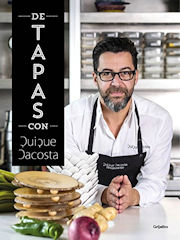 De tapas con Quique Dacosta by Quique Dacosta, March 2016 (in Spanish)
De tapas con Quique Dacosta by Quique Dacosta, March 2016 (in Spanish)
As a purely visual and recipe book, this one would deserve five stars. It’s beautifully presented, the recipes are tantalizing, the instructions are clear. Like many modernist cookbooks, there’s much in here that the average home cook, and even many of us who work in the profession, might take inspiration from, but look at it as “that’s too much work for an hors d’oeuvre”. It helps to have a kitchen with a dozen or two dozen cooks each responsible for small parts of something. When you’re working by yourself in the kitchen, it’s a lot more daunting.
But for me what stopped it from being a five star book is that there’s just very little in the way of anything other than recipes here. The few bits of narrative are interesting, but there aren’t enough of them. I found myself wanting to know more about the man, the restaurant, and the inspirations behind the recipes. Perhaps that’s for another book. This one goes more on the reference shelf than anywhere else. ****
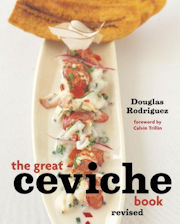 The Great Ceviche Book, revised, by Douglas Rodriguez, June 2010
The Great Ceviche Book, revised, by Douglas Rodriguez, June 2010
Thoroughly enjoyed this book. Not only is it a great overview of the wide range of ceviche, but it’s fun to read. Rodriguez’ stories about finding interesting versions of ceviches and the places he’s discovered them are intriguing and make me want to travel to many of those places (yes, there are still parts of Central and South America I haven’t made it to yet). If I have any criticism of that part of the content of the book it’s that given that the book is ostensibly an in-depth introduction to the subject, it lacks a little bit in the explorations of the regional and national differences in what goes into making a ceviche, and a bit more on the traditional versions.
That said, I’ve tried several of the recipes, which are mostly oriented towards his modern, updated takes on the traditions, and they’ve turned out beautifully, and inspired me to go on and invent a couple of my own. That deserves five stars, no? *****
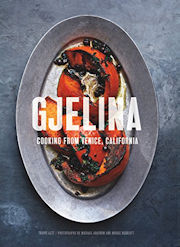 Gjelina: California Cooking from Venice Beach, by Travis Lett, October 2015
Gjelina: California Cooking from Venice Beach, by Travis Lett, October 2015
Oh boy… I know this place is one of the darlings of the southern California dining world. I know the chef is “all that”. And I know that among the foodie world, not giving this one a full on five star review is probably heretical. It is, no doubt, a beautifully photographed book (photos by Michael Graydon and Nikole Herriott). It’s even a well written book, enjoyable to flip through, to stop and read through the inspirations for a dish, etc., etc.
Lett spends much time in the first chapter or so assuring the reader that no special equipment is needed, no special ingredients are needed, and that all can be whipped up by anyone with a decent cooking ability. He then launches into recipes that require expensive special equipment and ingredients, things that need to be ordered from far-flung companies days, if not weeks, in advance, and a level of prep work that at times could tax a kitchen brigade. Even that would be fine if he offered up alternatives – “if you don’t have this piece of equipment, here’s a way to come up with a close variant”, “if you can’t find this ingredient, here’s a good substitute”. But he doesn’t. I think for most buyers, this book would become little more than one that rotates on and off the coffee-table, for show. ***
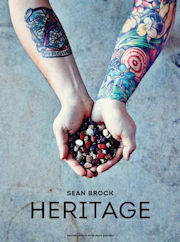 Heritage, by Sean Brock, October 2014
Heritage, by Sean Brock, October 2014
Although this is a cookbook, it’s really more of a storybook. It’s Brock’s story of becoming a chef, becoming involved, even leading, the movement to return to using locally produced products and heritage or heirloom ones. I found the stories of finding these nearly lost ingredients and the people who farm or raise them to be fascinating. And, I particularly like that he then takes those ingredients and uses them in both traditional preparations and modern ones – showing their versatility.
Now, as a cookbook, it’s definitely a bit more “chef-y” than many. A lot of the recipes, while they don’t require too many fancy techniques or special equipment, require a level of cooking knowledge and instinct in the kitchen that many home cooks (and more than a few professionals) don’t possess. He casually tosses off preparation or cooking instructions as if anyone reading the book would instantly know what he’s talking about, and how to adjust for their own kitchens. It probably would have benefited from a critical read from one or another home cooks who could have asked him those questions before publication. That said, for anyone with an interest in both heritage and/or southern cooking, this is a great library and kitchen addition. ****
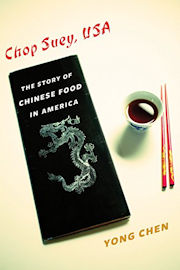 Chop Suey, USA: The Story of Chinese Food in America, by Yong Chen, November 2014
Chop Suey, USA: The Story of Chinese Food in America, by Yong Chen, November 2014
An interesting and in-depth read into the history of not only Chinese food, but that of Chinese immigrants and their diaspora in the U.S. It’s comprehensive, it’s well written, it’s got some great little stories, as well as personal insights on the part of the author and those whom he interviewed. Of most interest to me, as a chef and food lover, are the stories of how many of the dishes (including the eponymous chop suey) came about as adaptations from traditional Chinese dishes to those we know and love in American Chinese cooking.
At the same time, it’s a little dry. A bit too much time spent on statistics and citations. I suppose that comes with the territory of being written by a professor of history. ***
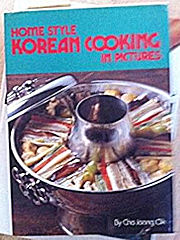 Homestyle Korean Cooking in Pictures, by Cho Joong Ok, September 1991
Homestyle Korean Cooking in Pictures, by Cho Joong Ok, September 1991
This is one of those books that someone gave me years and years ago and I don’t know that I ever gave it more than a cursory glance before it got stuck away. I may have flipped through it, I really don’t recall. But I came across it recently in my bookcase and decided to give it a go.
It is what it says it is. It’s very basic, homestyle Korean cooking. There’s a picture of each dish, followed by a recipe, with a few illustrations for some of the techniques that weren’t likely to be known to the western reader at the time the book was published. There’s basically nothing else to the book – no stories, minimal introduction. It’s basically a bunch of recipe cards bound together, if you think about it. With pretty pictures (not really book quality ones for the most part, but at least good enough to get a sense of what the dish should look like). ***
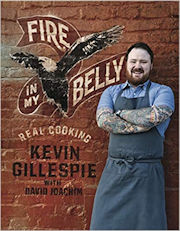 Fire in My Belly: Real Cooking, by Kevin Gillespie and David Joachim, October 2012
Fire in My Belly: Real Cooking, by Kevin Gillespie and David Joachim, October 2012
Gillespie was, and still is, one of my favorite contestants on Top Chef, not just for his season, but across the board. I liked his approach to cooking, to ingredients, and to other people. He just came across as a genuine, warm person, with a passion for what he does. And, that carries through into this book. I found myself along for the ride as he talked about his formation as a chef, and how he developed his style of cooking.
The book is well written, nicely illustrated, and has recipes that I think most decent home cooks, as well as pros, could jump right in and use. Nothing special is required other than an avid desire to produce a delicious dish and some standard cooking equipment along with ingredients that almost anyone should have access to. ****
Thanks for these reviews.
I really hate it when I get a cookbook where the recipe requires a tablespoon of $48 oil, and then it goes rancid in my cupboard.
Julie
You and me both! I don’t mind when that’s the ingredient that the chef may happen to use, but offer some substitution suggestions.